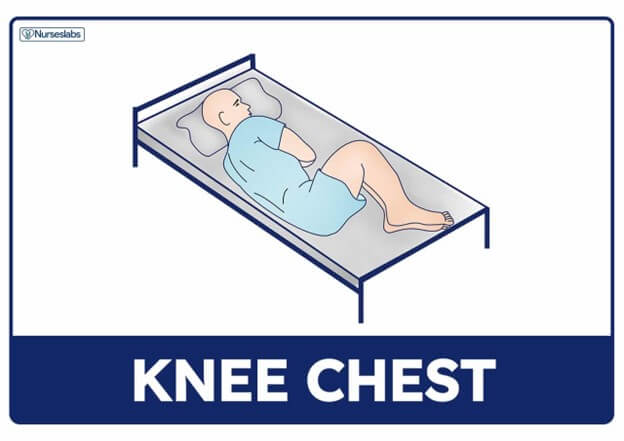Umbilical cord prolapse > Maternal & Newborn
Exam Review
Nursing interventions and management
Total Questions : 4
Showing 4 questions, Sign in for moreA nurse is caring for a client who is in labor and has a prolapsed umbilical cord.
Which of the following actions should the nurse take first?
Explanation
The correct answer is choice D. Reposition the client to a knee-chest position.This is because this position can reduce the pressure of the fetal presenting part on the prolapsed cord and improve fetal oxygenation.The nurse should also call for assistance and notify the provider, administer oxygen at 8 to 10 L/min via a face mask, and apply a warm, sterile, saline-soaked towel to the visible cord, but these are not the first actions to take.
Choice A is wrong because applying a warm, sterile, saline-soaked towel to the visible cord is not the first action to take.This intervention can prevent drying and atrophy of the umbilical vessels, but it does not relieve cord compression.
Choice B is wrong because administering oxygen at 8 to 10 L/min via a face mask is not the first action to take.This intervention can increase fetal oxygenation, but it does not relieve cord compression.
Choice C is wrong because calling for assistance and notifying the provider is not the first action to take.This intervention is necessary to prepare for emergency delivery, but it does not relieve cord compression.

A nurse is reviewing the risk factors for umbilical cord prolapse with a group of nursing students.
Which of the following factors should the nurse include? (Select all that apply.).
Explanation
The correct answer is choice A, B and E. Umbilical cord prolapse is a complication that occurs when the umbilical cord descends through the cervix before or with the presenting part of the fetus.
This can cause fetal hypoxia due to occlusion or vasospasm of the cord.
The risk factors for cord prolapse include:
• Premature rupture of membranes(choice A): This can cause the cord to slip past the fetal head or limbs when the amniotic fluid gushes out.
• Breech presentation(choice B): This is when the fetus is positioned with its feet or buttocks first.In a footling breech, the cord can easily slip between and past the fetal feet and into the pelvis.
• Cephalopelvic disproportion(choice C): This is when the fetal head is too large to fit through the maternal pelvis.This is not a risk factor for cord prolapse, as the fetal head usually prevents the cord from descending.
• Gestational diabetes(choice D): This is a condition where the mother has high blood sugar levels during pregnancy.This can cause macrosomia (large baby), but this is not a direct risk factor for cord prolapse.
• Hydramnios(choice E): This is a condition where there is excessive amniotic fluid around the fetus.This can create more space for the cord to move and prolapse, especially if there is a sudden loss of fluid.
Normal ranges for amniotic fluid index
A nurse is monitoring a client who is in labor and has meconium-stained amniotic fluid.
The nurse should identify that this finding can indicate which of the following conditions?
Explanation
The correct answer is choice A. Fetal hypoxia.Meconium-stained amniotic fluid is often caused by fetal hypoxia or other physiologic stress.Any reflexive “gasping” of the unborn fetus, due to hypoxia, can depress the fetal diaphragm mechanically, squeezing the contents of the bowels into the amniotic fluid.Meconium is a sign of fetal distress, either on-going or old.
Choice B. Fetal infection is wrong because meconium-stained amniotic fluid is not a direct indicator of fetal infection.However, fetal infection can cause fetal hypoxia and distress, which can lead to meconium passage.
Choice C. Fetal maturity is wrong because meconium-stained amniotic fluid is not a sign of fetal maturity.It is more common in full-term or post-term babies, but it can also occur in preterm babies.
Choice D. Fetal distress is wrong because it is too vague and nonspecific.Fetal distress can have many causes and manifestations, such as abnormal heart rate patterns, reduced fetal movements, or acidosis.
Meconium-stained amniotic fluid is one possible sign of fetal distress, but not the only one.

A nurse is performing a vaginal examination on a client who is in labor and notices a loop of umbilical cord protruding from the vagina.
Which of the following actions should the nurse take to relieve pressure on the cord?
Explanation
The correct answer is choice B. Place two fingers on either side of the cord and lift the fetal head off of it.
This action can relieve pressure on the cord and prevent fetal hypoxia until delivery can take place.
Choice A is wrong because pushing the cord back into the vagina can cause more damage to the cord and increase the risk of infection.
Choice C is wrong because clamping and cutting the cord will cut off the fetal blood supply and result in fetal death.
Choice D is wrong because pulling gently on the cord can cause cord avulsion or rupture of the uterus, both of which are life-threatening complications.
Normal ranges for umbilical cord pH are 7.18 to 7.38 and for umbilical cord base excess are -8 to +2 mmol/L.
: Cord Prolapse Nursing Management - RNpedia
Sign Up or Login to view all the 4 Questions on this Exam
Join over 100,000+ nursing students using Nursingprepexams’s science-backend flashcards, practice tests and expert solutions to improve their grades and reach their goals.
Sign Up Now

